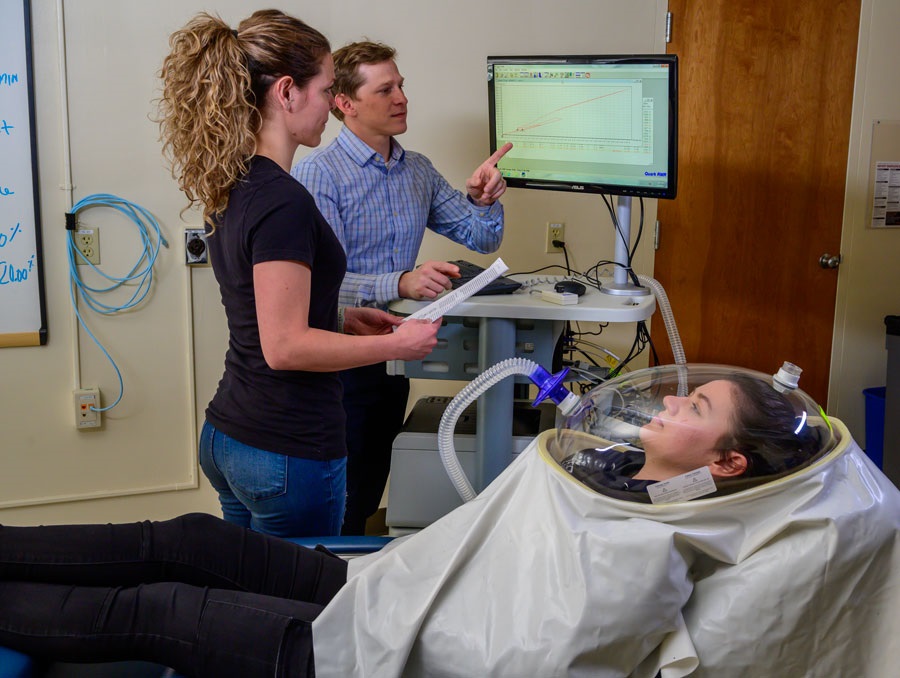There are many tools used to assess malnutrition in kidney disease patients, but making the right diagnosis takes some careful interpretation and consideration of all factors. This goes beyond measuring dietary intake and weight on a scoring system and into considering social factors and other conditions a patient may be experiencing.
A new assessment plan built by a team of six international researchers led by University of Nevada, Reno Assistant Professor David St-Jules aims to give more context to assessing malnutrition, broadening the scope of factors considered to help the medical community more effectively treat malnutrition affecting kidney disease patients and others.
The assessment plan is laid out in a Journal of Renal Nutrition article, “Deconstructing Disease-Related Malnutrition: A New Assessment Framework for Clinical Practice.” St-Jules, in the Department of Nutrition in the University’s College of Agriculture, Biotechnology & Natural Resources, has written dozens of research papers in the realm of critical analysis.
“The type of research I do brings together and synthesizes what we know, and then explores things where there is controversy or gaps in our understanding and brings them to light,” St-Jules, who also conducts research as part of the College’s Experiment Station unit, said.
In this recent article, St-Jules and his colleagues want to encourage a re-think in terms of how clinicians approach assessment, especially how certain tools can work together when assessing a care plan for malnutrition, rather than just sticking to a singular tool.
“Each of these tools are good for providing consistent documentation,” St-Jules explained. “But do they work equally well for every single patient and collect all of the information necessary to assess malnutrition? We clearly think not.”
St-Jules believes that the different assessment tools are missing some factors that would make them more effective for patients, although the article intentionally stops short of criticizing specific tools by name.
“There are way too many factors to consider, and we really wanted clinicians to use their judgment and also follow what they find during an examination,” he said.
A more thorough approach

The article advocates for clinicians to think critically about what tools do (and do not) measure, and take into consideration other factors when determining malnutrition risk. Tools commonly assess what are called downstream factors, such as impaired function, and upstream factors, such as inflammation, but do not specify how these factors impact the interpretation of malnutrition risk.
The new assessment plan provides an additional framework to be considered as part of using the tools that already exist, or as a complement to them. The framework breaks down malnutrition assessment into three, interacting parts:
Nutrient Balance: Is the patient obtaining enough nutrition? This can be assessed through measurements of dietary intake, recovery biomarkers and changes in nutrition status (discussed below). Clinicians use this information to determine if inadequate intake is a problem, and therefore amenable to diet intervention. Also, it indicates potential treatment targets and considerations for developing a tailored diet care plan.
Nutrition Status: Does the patient have adequate nutrition stores? In standard malnutrition assessment tools, this is usually based on energy and protein stores, although other nutrient deficiencies can also be an issue. This can be assessed through measurements of fat mass, lean body mass, concentration biomarkers and functional tests. Clinicians use this information to determine the urgency for diet intervention. However, St-Jules and his colleagues point out that adequate nutrition stores does not mean that intervention is unwarranted.
Malnutrition Risk: What is causing malnutrition risk in this patient? This includes a wide range of factors, such as the patient’s diseases or conditions; metabolic abnormalities; treatments taking place; symptoms the patient is experiencing; and personal factors, potential food insecurity or depression, for example. These indicate the specific nutrients at risk and what needs to be targeted or considered for treatment.
St-Jules believes this framework provides more clarity on how these three factors interact to determine the individual needs of the patient.
“Giving the same weight to a point system with these tools doesn’t give due consideration to some of the problems that patients might be experiencing,” he said. “Clinicians need to be careful about the interpretations they make and really take the time to see what they find. This framework organizes those interpretations in a way that allows for better planning in clinical judgement.”
Creating and testing theories
Though the intended audience is clinicians, St-Jules wanted to point out that this is a theoretical system that hasn’t been tested as part of the article’s data.
“We’re writing it as a conceptual model to help clinicians think more about nutrition,” he said. “We are trying to capture everything and not miss key details, but at the end of the day, time will tell what value this framework provides. But we are hopeful that it will be useful in providing the best recommendations and care.”
St-Jules worked on the article with five other international nutrition colleagues with key expertise and experiences in assessing malnutrition of patients with kidney disease:
- Lyn Lloyd, senior renal dietitian, Nutrition and Dietetics, Te Toka Tumai Hospital in Auckland, New Zealand
- Anthony Meade, advanced renal dietitian, Central Northern Adelaide Renal and Transplantation Service, Royal Adelaide Hospital in Australia
- Annabel Biruete, assistant professor, Department of Nutrition Science, Purdue University in Indiana, and Division of Nephrology for the Indiana University School of Medicine
- Brandon Kistler, assistant professor, Department of Nutrition Science, Purdue University
- Juan-Jesus Carrero, professor, Department of Medical Epidemiology and Biostatistics, Karolinska Institute, Stockholm, Sweden; and the Division of Nephrology, Department of Clinical Sciences, Danderyd Hospital, Stockholm
Putting it into practice
St-Jules has started to use the findings in his article for nutrition science graduate student coursework and the training of nutrition science interns at the University. It will also soon be used in the master's program for dietitians.
“I teach nutrition assessment and I’ve used my framework to have students assess one particular tool to think about the parameters and how they are scored,” St-Jules said. “This is to think about malnutrition in context of the tools and understand the limitations and uses."
Since the article was published, he has also heard about some clinical treatment groups discussing the theories behind it.
“For me, right off the bat, that is a success – that someone would apply some of this thinking in their practice,” St-Jules said.















